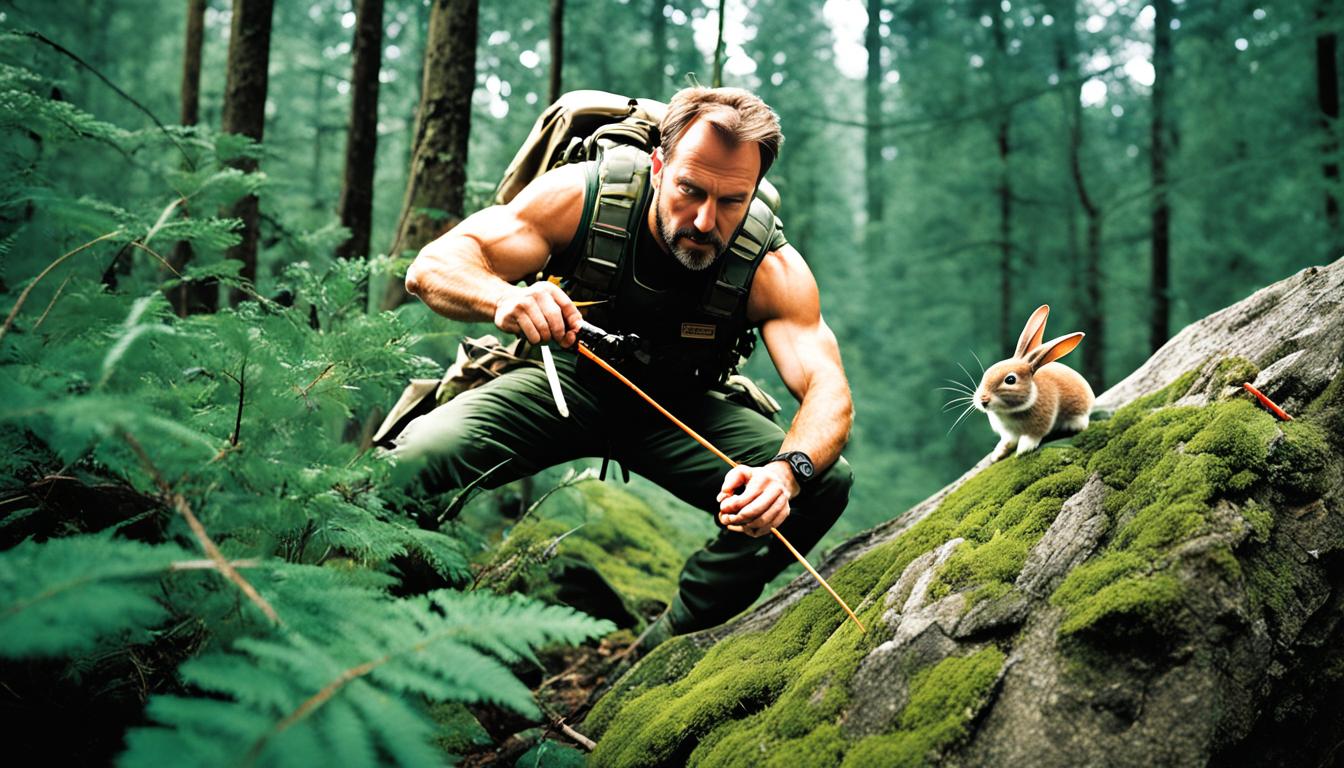As an avid outdoorsman and wilderness survival enthusiast, I’ve honed the art of hunting rabbits with a slingshot over the years. In this comprehensive guide, I’ll share my proven techniques and essential skills to help you effectively and ethically secure a reliable food source in the wild using this simple yet powerful tool. Whether you’re an experienced outdoorsman or a beginner looking to enhance your survival skills, you’ll learn how to hunt rabbits with a slingshot and thrive in any survival situation.
Mastering the art of slingshot hunting is a valuable skill that can mean the difference between life and death in a survival scenario. By learning how to choose the right slingshot and ammunition, as well as develop accuracy and precision, you’ll be well on your way to providing for yourself and your loved ones in the wilderness. In the following sections, I’ll guide you through the essential techniques and strategies for tracking, stalking, and successfully hunting rabbits with a slingshot.
Mastering the Art of Slingshot Hunting
If you’re seeking to master the art of slingshot hunting for rabbits, the key lies in selecting the right slingshot and ammunition, as well as developing the necessary accuracy and precision through targeted practice. By investing time and effort into these crucial aspects, you’ll position yourself for successful rabbit hunts and self-sufficient survival.
Choosing the Right Slingshot and Ammunition
The slingshot you choose can significantly impact your hunting success. Look for a high-quality slingshot with a sturdy frame and comfortable grip. The elastic bands should be durable and provide ample power to propel your projectiles with force. Additionally, experiment with different types of ammunition, such as steel balls, lead pellets, or even small stones, to find the combination that works best for your slingshot and the terrain you’ll be hunting in.
Developing Accuracy and Precision
Slingshot hunting requires a keen eye and a steady hand. Spend time practicing your shooting technique, refining your stance, and learning how to compensate for factors like wind and distance. Consistent practice is the key to improving your slingshot accuracy and precision, which will be crucial when hunting agile rabbits in the wild.
Remember, mastering the art of slingshot hunting takes patience and dedication. But with the right equipment and a commitment to honing your skills, you’ll be well on your way to becoming an effective and self-sufficient rabbit hunter, equipped with the knowledge and techniques to thrive in survival situations.
“The key to successful slingshot hunting is in the details – the right equipment and the right practice to develop the necessary accuracy and precision.”
Tracking and Stalking Rabbits in the Wild
Successful rabbit hunting with a slingshot requires the ability to effectively track and stalk your prey in their natural habitat. By learning to identify prime rabbit habitats and recognize the telltale signs of their presence, you can employ stealthy stalking techniques to get within striking range for a clean, ethical shot.
Identifying Rabbit Habitats and Signs
Rabbits thrive in areas with ample cover, such as dense shrubs, tall grasses, and abandoned burrows. Look for these types of environments, as they provide the perfect blend of food, water, and protection that rabbits seek. Once you’ve located a promising habitat, keep an eye out for the following signs of rabbit activity:
- Tracks and trails: Rabbits leave distinct, narrow footprints in the soil, often in a hopping pattern.
- Droppings: Rabbit droppings are small, round, and pellet-like, typically found in piles or scattered around their burrows and feeding areas.
- Feeding signs: Rabbits leave behind telltale signs of their feeding, such as partially eaten vegetation and gnawed bark on low-lying plants and trees.
- Burrows: Rabbits make their homes in underground burrows, often with multiple entrances and extensive tunnel systems.
![]()
Stalking Techniques for Slingshot Hunting
Once you’ve identified a promising rabbit habitat and located the signs of their presence, it’s time to employ stealthy stalking techniques to get within range for a clean shot with your slingshot. Move slowly and deliberately, keeping low to the ground and using any available cover to stay out of sight. Avoid sudden movements or loud noises that could startle your prey. With patience and practice, you’ll be able to consistently close the distance and take ethical shots at your quarry.
“Successful rabbit hunting is all about understanding your prey and its environment. By mastering the art of tracking and stalking, you’ll be well on your way to providing nutritious, sustainable meat for your family.”
How to Hunt Rabbit with a Slingshot for Survival
In this final section, I’ll guide you through the complete process of hunting rabbits with a slingshot. From meticulous pre-hunt preparation to the ethical dispatch of your prey and field dressing techniques, I’ll help you put all the skills and knowledge you’ve gained into practice. This ensures a successful and responsible rabbit hunt that can provide a valuable source of sustenance in a survival situation.
Mastering the slingshot rabbit hunting techniques is crucial for an ethical and effective hunt. I’ll teach you how to approach your target with stealth and precision, maximizing your chances of a clean shot. Additionally, I’ll emphasize the importance of ethical rabbit hunting practices, ensuring that your prey is dispatched quickly and humanely.
In a survival scenario, hunting with a slingshot can be a vital skill for securing food and sustenance. I’ll guide you through the entire process, from identifying the best rabbit habitats to the field dressing and preparation of your catch. By the end of this section, you’ll be equipped with the knowledge and confidence to embark on successful and responsible rabbit hunts using your trusty slingshot.



